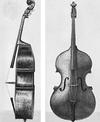- double bass
-
—double bassist./bays/the largest instrument of the violin family, having three or, usually, four strings, rested vertically on the floor when played. Also called bass fiddle, bass viol, contrabass, string bass.[1720-30]
* * *
It varies in size, up to 80 inches (200 cm) tall. Its shape also varies; its shoulders usually slope more than those of the violin, reflecting its status as a hybrid of the viol and violin families (the name comes from the double-bass viol). It emerged from these families in the late Renaissance, and it has always been less standardized in form than its cousins in the violin family. It normally has four strings; the orchestral instrument often has a lower fifth string (more often, an extension is added to the fourth string), and the jazz instrument has a higher fifth string. Its range is an octave below that of the cello. It is normally bowed in orchestral music and plucked in jazz. In rock bands and some jazz bands, the electric bass is used instead. Double bass, viol-shaped, side and front viewsEncyclopædia Britannica, Inc.
Double bass, viol-shaped, side and front viewsEncyclopædia Britannica, Inc.* * *
also called contrabass, string bass, bass, bass viol, bass fiddle, or bull fiddle French contrebasse, German Kontrabassstringed musical instrument (stringed instrument), the lowest-pitched member of the violin family, sounding an octave lower than the cello. It has two basic designs—one shaped like a viol (or viola da gamba) and the other like a violin—but there are other designs, such as that of a guitar. It varies considerably in size, the largest normally being under 6 feet (1.8 metres) in total length. The body itself, without the neck, may be up to 4.5 feet (1.4 metres) for a full-size instrument, about 3.8 feet (1.2 metres) for a three-quarter size, and only slightly larger than a cello for the small chamber bass, or bassetto. A double bass is usually strung with four heavy strings pitched E1–A1–D–G; a fifth string is occasionally added—in jazz band basses, at the top of the register to allow high notes to be played more easily; in symphony orchestra basses, below the E string, tuned to C. Many basses, rather than having a fifth string, have a mechanical device with levers that increases the length of the fourth string. With this device the pitch of the E string may be lowered to E♭, D, D♭, or C, or clamped to sound E when the lower notes are not needed.Two styles of bass bow are currently used: the short and narrow French bow (like a violin bow), held palm downward, and the broader German bow (like a viol bow), held palm upward. The double bass also can be played pizzicato (by plucking with the fingers)—occasionally in symphonic orchestras and almost always in jazz and dance bands.Forms of the double bass date from the late 15th or early 16th century and were in common use by the 18th century. Ludwig van Beethoven (Beethoven, Ludwig van) and later composers gave the bass increased importance in the symphony orchestra. Beethoven's friend Domenico Dragonetti and the conductor Serge Koussevitzky (Koussevitzky, Serge), both skilled bassists, composed concerti for the instrument.In jazz ensembles the bass forms part of the rhythm section and is also used as a melody instrument. It is often electronically amplified when played with such groups; an electric upright bass—a slender instrument that is easier to transport—is also common. In most rock and some jazz bands, the place of the double bass is taken by the electric bass guitar.* * *
Universalium. 2010.
